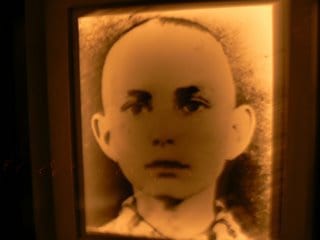Haunting Face at Caen’s Memorial Museum
 This haunting image fades to black every 10 seconds, signifying the horrific number of deaths in the Nazi-run concentration camps of World War II. The museum takes you on a journey beginning in the 1918, and lays out a time-line that began with World War I’s Treaty of Versailles, through the worldwide depression, and ending with the final days of the war in Europe in May, 1945. An attempt is made to show how one begat another and how people in such desperate straights as pre-war Germans would ever vote in such a monster as Hitler.
This haunting image fades to black every 10 seconds, signifying the horrific number of deaths in the Nazi-run concentration camps of World War II. The museum takes you on a journey beginning in the 1918, and lays out a time-line that began with World War I’s Treaty of Versailles, through the worldwide depression, and ending with the final days of the war in Europe in May, 1945. An attempt is made to show how one begat another and how people in such desperate straights as pre-war Germans would ever vote in such a monster as Hitler.
I came away with many thoughts after this startling collection of video, memorabilia, photographs, audio of speeches and even two young actors speaking in costume the roles of Jewish citizens.
Much is made here of the fact that France was so quick to sign a peace treaty and become one the occupied territories of the Axis; we hear a speech by General De Gaulle pleading with his countrymen not to sign, and to resist. The French today or at least the people who created this impressive huge trove of historical relics seem to feel that the government of France did a great disservice by being so easy to conquer.
Another display showed the V1 rockets that Germany used to bomb England, which in the early 1940s had already started the use of missiles to kill people. A map provided chilling details about the vast galaxy of extermination and detention camps all over Poland and Germany, and showed how officers and political prisoners were sent to different camps than Jews, gypsys and other people that Hitler wanted to extinguish from the world. Letters written by GIs gave a glimpse of wha t they went through, and a chart at the very beginning showed that Germany and Russia lost the most lives in the long, terrible war in Europe.
t they went through, and a chart at the very beginning showed that Germany and Russia lost the most lives in the long, terrible war in Europe.
A visit to the D-Day beaches and the many memorials there brought the museum’s vast collection into a sharper focus. Trees at the US-maintained American cemetary are trimmed like giant hedges, and row upon row of crosses intermingled with stars of David each show the name, rank and state where the dead serviceman came from. Many just say ‘here rests a comrade in arms known but to God.’
